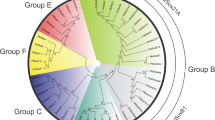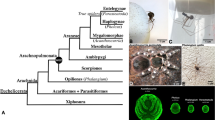Abstract
Zinc finger transcription factors of the Sp6–9 group are evolutionarily conserved in all metazoans and have important functions in, e.g., limb formation and heart development. The function of Sp6–9-related genes has been studied in a number of vertebrates and invertebrates, but data from chelicerates (spiders and allies) was lacking so far. We have isolated the ortholog of Sp6–9 from the common house spider Parasteatoda tepidariorum and the cellar spider Pholcus phalangioides. We show that the Sp6–9 gene in these spider species is expressed in the developing appendages thus suggesting a conserved role in limb formation. Indeed, RNAi with Sp6–9 in P. tepidariorum leads not only to strong limb defects, but also to the loss of body segments and head defects in more strongly affected animals. Together with a new expression domain in the early embryo, these data suggest that Sp6–9 has a dual role P. tepidariorum. The early role in head and body segment formation is not known from other arthropods, but the role in limb formation is evolutionarily highly conserved.











Similar content being viewed by others
References
Akiyama-Oda Y, Oda H (2003) Early patterning of the spider embryo: a cluster of mesenchymal cells at the cumulus produces Dpp signals received by germ disc epithelial cells. Development 130:1735–1747
Akiyama-Oda Y, Oda H (2010) Cell migration that orients the dorsoventral axis is coordinated with anteroposterior patterning mediated by Hedgehog signaling in the early spider embryo. Development 137:1263–1273
Angelini DR, Kaufman TC (2005) Insect appendages and comparative ontogenetics. Dev Biol 286:57–77
Beermann A, Aranda M, Schröder R (2004) The Sp8 zinc-finger transcription factor is involved in allometric growth of the limbs in the beetle Tribolium castaneum. Development 131:733–742
Chung HA, Medina-Ruiz S, Harland RM (2014) Sp8 regulates inner ear development. Proc Natl Acad Sci U S A 111:6329–6334
Cohen SM, Jürgens G (1990) Mediation of Drosophila head development by gap-like segmentation genes. Nature 346:482–485
Cordoba S, Requena D, Jory A, Saiz A, Estella C (2016) The evolutionarily conserved transcription factor Sp1 controls appendage growth through Notch signaling. Development 143:3623–3631
Farzana L, Brown SJ (2008) Hedgehog signaling pathway function conserved in Tribolium segmentation. Dev Genes Evol 218:181–192
Foelix R (2011) The biology of spiders, 3rd edn. Oxford University Press, Oxford, pp 270–272
Haro E, Delgado I, Junco M, Yamada Y, Mansouri A, Oberg KC, Ros MA (2014) Sp6 and Sp8 transcription factors control AER formation and dorsal-ventral patterning in limb development. PLoS Genet 10:e1004468
Hertveldt V, Louryan S, van Reeth T, Drèze P, van Vooren P, Szpirer J, Szpirer C (2008) The development of several organs and appendages is impaired in mice lacking Sp6. Dev Dyn 237:883–892
Kanayama M, Akiyama-Oda Y, Nishimura O, Tarui H, Agata K, Oda H (2011) Travelling and splitting of a wave of hedgehog expression involved in spider-head segmentation. Nat Commun 2:500
Kawakami Y, Esteban CR, Matsui T, Rodríguez-León J, Kato S, Izpisúa Belmonte JC (2004) Sp8 and Sp9, two closely related buttonhead-like transcription factors, regulate Fgf8 expression and limb outgrowth in vertebrate embryos. Development 131:4763–4774
Koga T, Matsui Y, Asagiri M, Kodama T, de Crombrugghe B, Nakashima K, Takayanagi H (2005) NFAT and Osterix cooperatively regulate bone formation. Nat Med 11:880–885
Li X, Sun C, Lin C, Ma T, Madhavan MC, Campbell K, Yang Z (2011) The transcription factor Sp8 is required for the production of parvalbumin-expressing interneurons in the olfactory bulb. J Neurosci 31:8450–8455
Mittmann B, Wolff C (2012) Embryonic development and staging of the cobweb spider Parasteatoda tepidariorum C. L. Koch, 1841 (syn.: Achaearanea tepidariorum; Araneomorphae; Theridiidae). Dev Genes Evol 222:189–216
Oda H, Nishimura O, Hirao Y, Tarui H, Agata K, Akiyama-Oda Y (2007) Progressive activation of Delta-Notch signaling from around the blastopore is required to set up a functional caudal lobe in the spider Achaearanea tepidariorum. Development 134:2195–2205
Pechmann M, McGregor AP, Schwager EE, Feitosa NM, Damen WG (2009) Dynamic gene expression is required for anterior regionalization in a spider. Proc Natl Acad Sci U S A 106:1468–1472
Pechmann M, Prpic NM (2009) Appendage patterning in the South American bird spider Acanthoscurria geniculata (Araneae: Mygalomorphae). Dev Genes Evol 219:189–198
Pechmann M, Khadjeh S, Turetzek N, McGregor AP, Damen WG, Prpic NM (2011) Novel function of Distal-less as a gap gene during spider segmentation. PLoS Genet 7:e1002342
Philipsen S, Suske G (1999) A tale of three fingers: the family of mammalian Sp/XKLF transcription factors. Nucleic Acids Res 27:2991–3000
Posnien N, Zeng V, Schwager EE, Pechmann M, Hilbrant M, Keefe JD, Damen WGM, Prpic NM, McGregor A, Extavour CG (2014) A comprehensive reference transcriptome resource for the common house spider Parasteatoda tepidariorum. PLoS One 9:e104885
Prpic NM, Schoppmeier M, Damen WGM (2008a) Collection and fixation of spider embryos. Cold Spring Harb Protoc 3:930–932. https://doi.org/10.1101/pdb.prot5067
Prpic NM, Schoppmeier M, Damen WGM (2008b) Whole-mount in situ hybridization of spider embryos. Cold Spring Harb Protoc 3:933–936. https://doi.org/10.1101/pdb.prot5068
Ronquist F, Huelsenbeck JP (2003) MrBayes 3: Bayesian phylogenetic inference under mixed models. Bioinformatics 19:1572–1574
Schaeper ND, Prpic NM, Wimmer EA (2009) A conserved function of the zinc finger transcription factor Sp8/9 in allometric appendage growth in the milkweed bug Oncopeltus fasciatus. Dev Genes Evol 219:427–435
Schaeper ND, Prpic NM, Wimmer EA (2010) A clustered set of three Sp-family genes is ancestral in the Metazoa: evidence from sequence analysis, protein domain structure, developmental expression patterns and chromosomal location. BMC Evol Biol 10:88
Schöck F, Purnell BA, Wimmer EA, Jäckle H (1999) Common and diverged functions of the Drosophila gene pair D-Sp1 and buttonhead. Mech Dev 89:125–132
Schwager EE, Pechmann M, Feitosa NM, McGregor AP, Damen WG (2009) hunchback functions as a segmentation gene in the spider Achaearanea tepidariorum. Curr Biol 19:1333–1340
Sievers F, Wilm A, Dineen D, Gibson TJ, Karplus K, Li W, Lopez R, McWilliam H, Remmert M, Söding J, Thompson JD, Higgins DG (2011) Fast, scalable generation of high-quality protein multiple sequence alignments using Clustal Omega. Mol Syst Biol 7:539
Suske G, Bruford E, Philipsen S (2005) Mammalian SP/KLF transcription factors: bring in the family. Genomics 85:551–556
Turetzek N, Pechmann M, Schomburg C, Schneider J, Prpic NM (2016) Neofunctionalization of a duplicate dachshund gene underlies the evolution of a novel leg segment in arachnids. Mol Biol Evol 33:109–121
Turetzek N, Prpic NM (2016) Observations on germ band development in the cellar spider Pholcus phalangioides. Dev Genes Evol 226:413–422
Wimmer EA, Jäckle H, Pfeifle C, Cohen SM (1993) A Drosophila homologue of human Sp1 is a head-specific segmentation gene. Nature 366:690–694
Acknowledgements
We thank Beate Preitz for the help with microscopy. We also thank all members of the department for comments that helped to improve the manuscript.
Funding
This work was supported by the Deutsche Forschungsgemeinschaft (grant numbers PR 1109/4-1 and PR 1109/6-1 to N.M.P. and PE 2075/1-1 and PE 2075/1-2 to M.P.). Additional financial backing has been received from the Göttingen Graduate School for Neurosciences, Biophysics and Molecular Biosciences (GGNB), the Göttingen Center for Molecular Biosciences (GZMB), and the University of Göttingen (GAU). N.T. has been supported by a Christiane-Nüsslein-Volhard-Foundation fellowship and a “Women in Science” award by L’Oréal Deutschland and the Deutsche UNESCO-Kommission. The funders had no role in study design, data collection and analysis, decision to publish, or preparation of the manuscript.
Author information
Authors and Affiliations
Corresponding author
Ethics declarations
Conflict of interest
N.M.P. is a member of the editorial board of Development Genes and Evolution serving as communicating editor for the topical collection “Size & Shape.”
Additional information
Communicated by Volker Hartenstein
Electronic supplementary material
Online Resource 1
(TXT 1 kb)
Online Resource 2
(TXT 4 kb)
Online Resource 3
(NEX 7 kb)
Online Resource 4
(JPEG 329 kb)
Online Resource 5
(JPEG 281 kb)
Online Resource 6
(JPEG 638 kb)
Rights and permissions
About this article
Cite this article
Königsmann, T., Turetzek, N., Pechmann, M. et al. Expression and function of the zinc finger transcription factor Sp6–9 in the spider Parasteatoda tepidariorum . Dev Genes Evol 227, 389–400 (2017). https://doi.org/10.1007/s00427-017-0595-2
Received:
Accepted:
Published:
Issue Date:
DOI: https://doi.org/10.1007/s00427-017-0595-2




